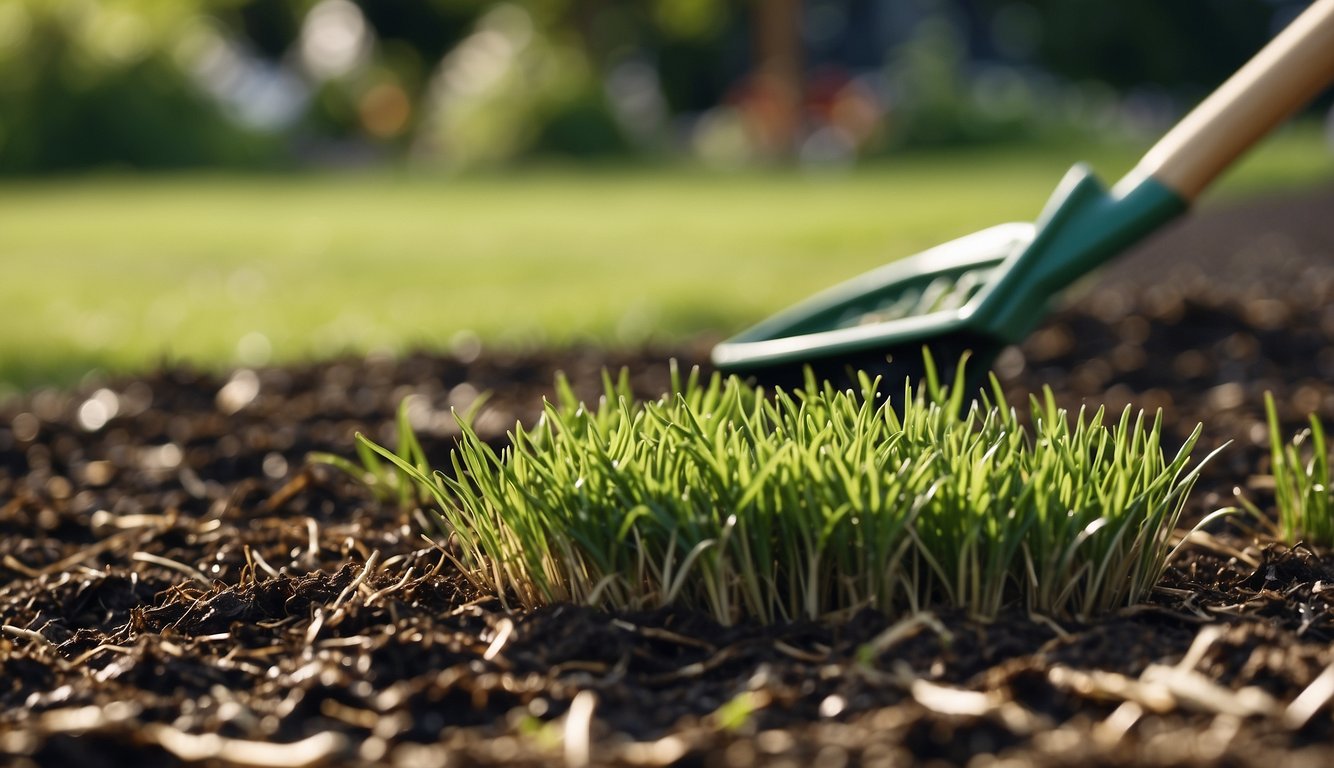How To Get Grass Clippings Out Of Mulch? If you’re a homeowner, you know maintaining your lawn is a never-ending task. One common problem is grass clippings in mulch beds. Not only does it look unsightly, but it can also cause problems for your plants by creating a breeding ground for insects and disease. In this article, I’ll share some tips on removing grass clippings from mulch and keeping your lawn looking its best.
One of the simplest ways to remove grass clippings from your mulch is to use a rake or leaf blower. This method is effective, but it can be time-consuming, especially if you have a large lawn. If you’re short on time, there are other methods you can use to get the job done more quickly. For example, you can use a lawn sweeper to collect clippings as you mow. You can find them in push or tow-behind variations, depending on your needs and the size of your lawn.
Understanding Lawn Maintenance
As a lawn owner, I understand the importance of keeping my lawn healthy and vibrant. One of the key aspects of maintaining a healthy lawn is proper lawn maintenance. In this section, I will discuss the role of grass clippings and the benefits of mulching mowers in lawn maintenance.
The Role of Grass Clippings
Grass clippings are a natural byproduct of mowing your lawn. While some homeowners may see them as a nuisance, grass clippings actually play an important role in lawn maintenance. Grass clippings contain essential nutrients such as nitrogen, phosphorus, and potassium that are vital for maintaining healthy soil and promoting lawn growth. When grass clippings are left on the lawn, they act as a natural fertilizer, returning these nutrients back to the soil. This means that frequent mowing can actually help to improve the health of your lawn.
Benefits of Mulching Mowers
Mulching mowers are designed to chop grass clippings into small pieces and distribute them evenly across the lawn. This is in contrast to traditional mowers, which collect grass clippings in a bag or discharge them out the side. Mulching mowers are a great option for homeowners who want to take advantage of the benefits of grass clippings without the mess. By leaving grass clippings on the lawn, mulching mowers help to improve soil health and reduce the need for additional fertilizers.
In addition to the benefits for lawn health, mulching mowers are also more environmentally friendly than traditional mowers. They demonstrate how to get grass clippings out of mulch without increasing the amount of yard waste that ends up in landfills. This means that homeowners can feel good about doing their part to reduce their environmental impact while still maintaining a healthy and vibrant lawn.
Understanding the role of grass clippings and the benefits of mulching mowers is key to maintaining a healthy and vibrant lawn. By utilizing mulching mowers and leaving grass clippings on the lawn, homeowners can improve soil health, reduce the need for additional fertilizers, and do their part to reduce their environmental impact.
Preparation for Removing Grass Clippings
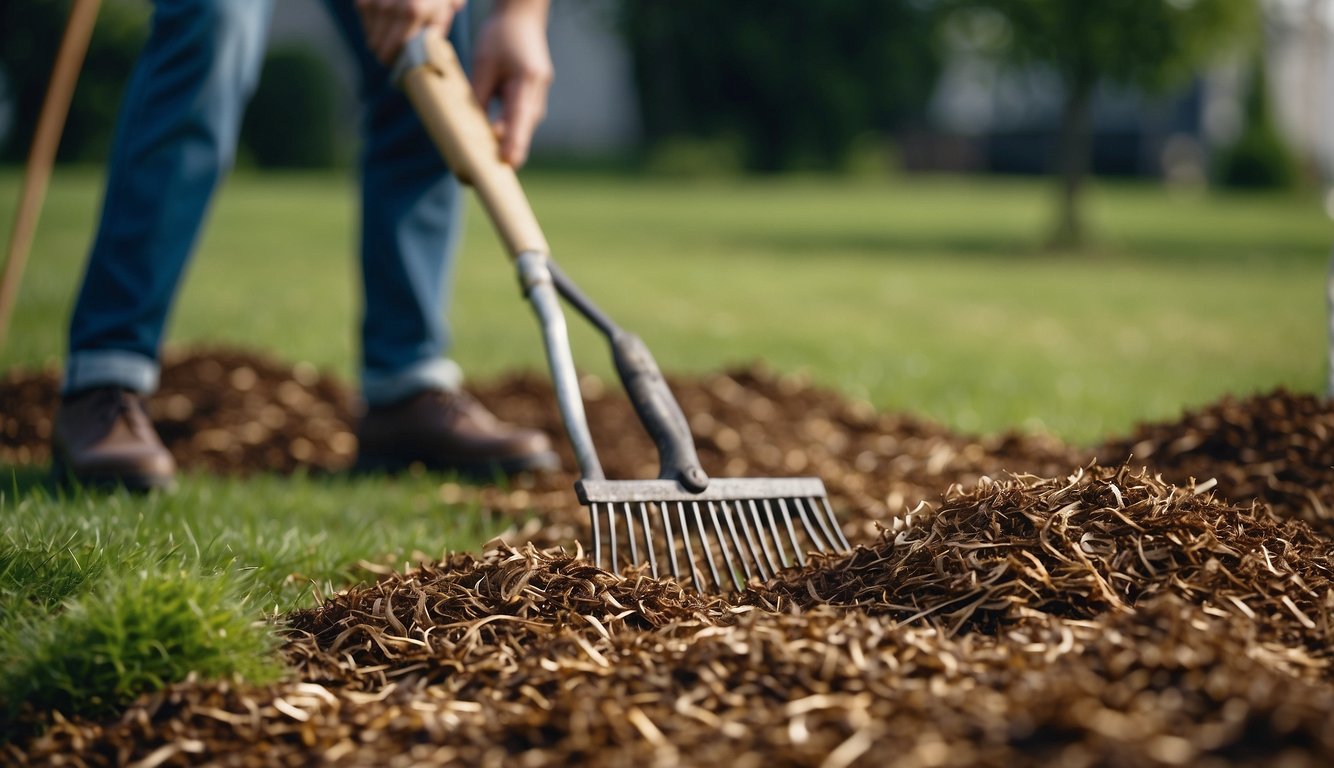
As a lawn owner, I know how important it is to keep the lawn clean and tidy. However, removing grass clippings from the mulch bed can be a daunting task. In this section, I will guide you through the preparation process for removing grass clippings from the mulch bed.
Gathering Necessary Tools
Before you begin removing the grass clippings, you need to gather the necessary tools. The tools you need will depend on the size of the mulch bed and the amount of grass clippings. Here are some of the tools you may need:
- Rake: A rake is the most common tool for removing grass clippings. A metal rake is best for scraping the clippings off the mulch bed easily.
- Bag: You may need a bag to collect the grass clippings. A large garbage bag can be used for this purpose.
- Leaf Blower: A leaf blower can be used to blow the grass clippings off the mulch bed. This is a quick and easy way to remove the clippings.
- Shovel: A shovel can be used to scoop up the grass clippings and transfer them to a bag.
- Garden Hose: A garden hose can be used to wash away the grass clippings from the mulch bed.
Assessing the Mulch Bed Condition
Before you learn how to get grass clippings out of mulch without causing damage, you need to assess the condition of the mulch bed. If the mulch bed is covered with a layer of landscape fabric, you need to remove it before figuring out how to get grass clippings out of mulch without disrupting the underlying fabric. Now, if there are weeds growing in the mulch bed, you need to remove them before discovering how to get grass clippings out of mulch without also pulling up these unwanted plants.
If the grass clippings are wet, it is best to wait for them to dry before removing them. Wet grass clippings can clump together and make it difficult to remove them from the mulch bed. You can also lay down newspaper on the mulch bed before mowing the lawn. The newspaper will absorb the moisture from the grass clippings and make them easier to remove.
Before removing grass clippings from the mulch bed, you need to gather the necessary tools and assess the condition of the mulch bed. By following these steps, you can make the task of removing grass clippings easier and more efficient.
Effective Removal Techniques
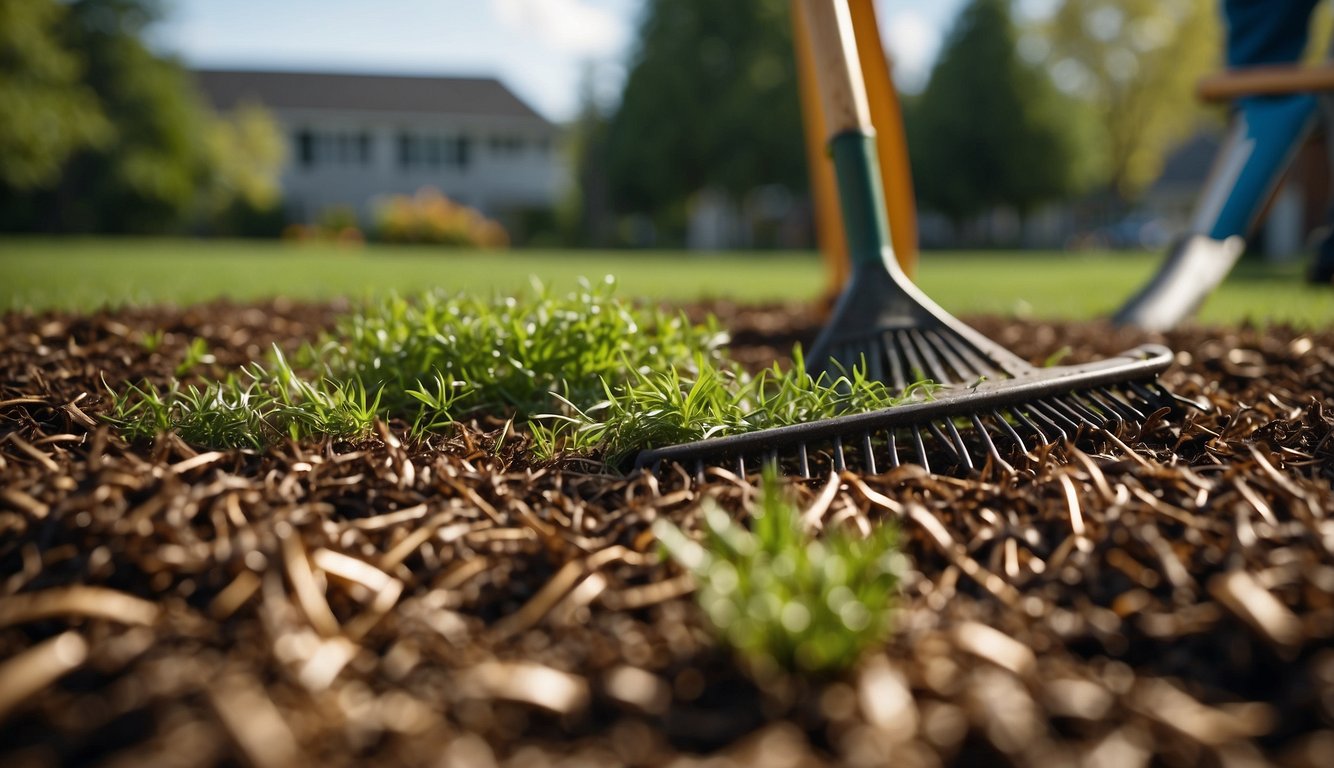
As a lawn care enthusiast, I have found that grass clippings can be a nuisance in mulch beds. Fortunately, there are various effective methods to remove grass clippings from mulch. In this section, I will discuss the three most popular methods that I have found to be effective: raking, blowing, and manual picking.
Raking Method
The raking method is a great way to remove grass clippings from mulch. It requires minimal effort and is a great way to keep your mulch looking cool and clean. To use this method, you will need a rake and a little bit of time. Start by raking the mulch bed in a circular motion, starting from the outside and working your way in. This will help to loosen any clumps of grass clippings and debris. Once you have raked the entire bed, use the rake to scoop up any clumps of grass clippings that you have loosened. Dispose of the clippings in a compost pile or other appropriate location.
Blowing Method
The blowing method is another effective way to remove grass clippings from mulch. This method requires a blower or leaf blower and is great for larger mulch beds. To use this method, start by blowing the mulch bed in a circular motion, starting from the outside and working your way in. This will help to loosen any clumps of grass clippings and debris. Once you have blown the entire bed, use the blower to blow any loose clumps of grass clippings out of the bed and into a pile. Dispose of the clippings in a compost pile or other appropriate location.
Manual Picking
The manual picking method is the most time-consuming but also the most effective way to remove grass clippings from mulch. This method requires no special tools, just your hands. To use this method, start by picking up any visible clumps of grass clippings and debris by hand. Be sure to wear gloves to protect your hands. Once you have picked up all of the visible clumps, use your fingers to sift through the mulch bed and pick out any remaining clumps. This method takes the most effort but is the most thorough way to remove grass clippings from mulch.
There are several effective methods to remove grass clippings from mulch, including raking, blowing, and manual picking. Each of these methods has its advantages, and the best method for you will depend on the size of your mulch bed and your personal preference.
Utilization of Grass Clippings
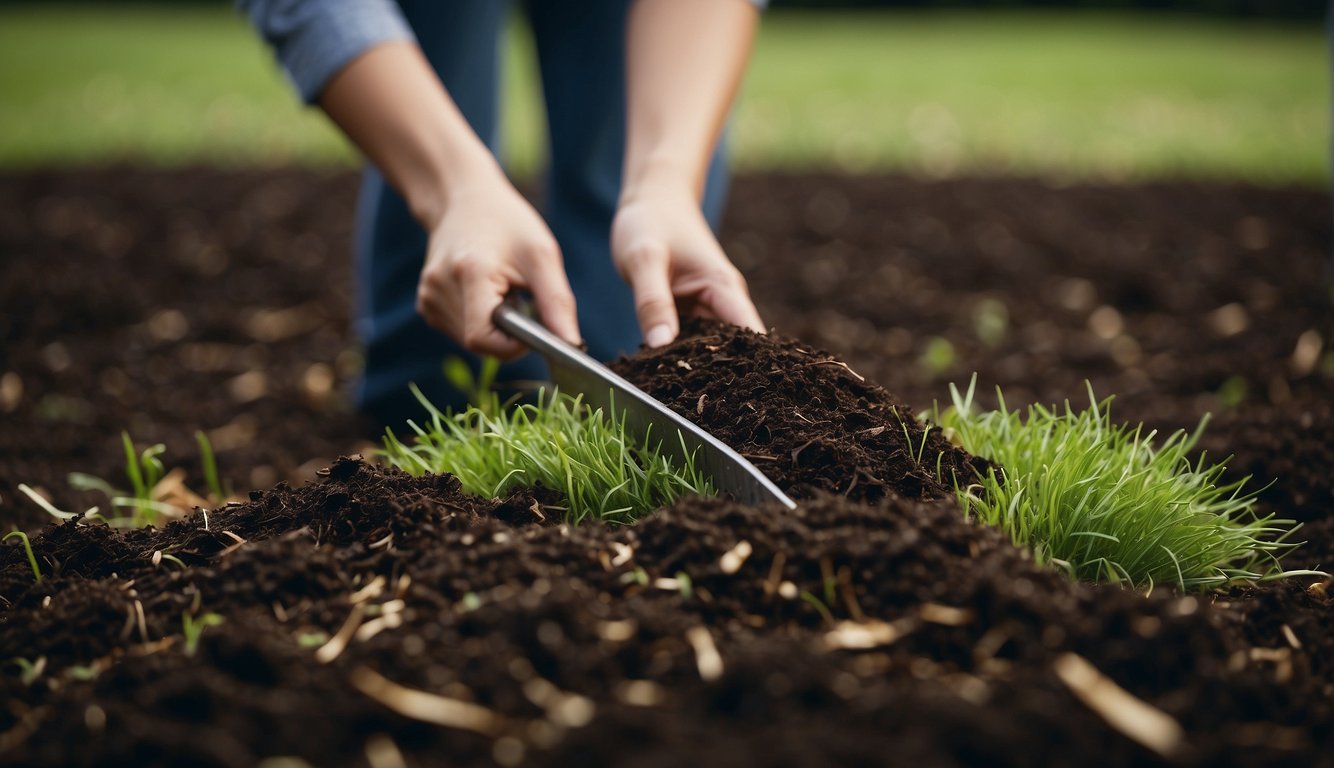
As a lawn owner, it is essential to know how to manage grass clippings after mowing your lawn. One way to handle them is by utilizing them. Grass clippings are an excellent source of nutrients for your lawn and garden. They contain nitrogen, phosphorus, and potassium, which are essential for plant growth. In this section, I will discuss two ways to utilize grass clippings.
How To Get Grass Clippings Out Of Mulch – Composting Grass Clippings
Composting is an excellent way of utilizing grass clippings. That’s the process of decomposing organic matter, such as grass clippings, into a nutrient-rich soil amendment known as compost. Composting grass clippings is an excellent way of recycling them and reducing the amount of waste that goes to landfills.
To compost grass clippings, you need to create a compost pile. A compost pile is a mixture of organic matter, such as grass clippings, leaves, and kitchen waste. The compost pile needs to be turned regularly to ensure that it decomposes evenly. Grass clippings are a great addition to a compost pile because they are rich in nitrogen, which is essential for the decomposition process.
Using Clippings as Fertilizer
Grass clippings can also be used as a natural fertilizer. When grass clippings decompose, they release nutrients such as nitrogen, phosphorus, and potassium, which are essential for plant growth. Using grass clippings as a natural fertilizer is an excellent way of recycling them and reducing the amount of waste that goes to landfills.
To use grass clippings as a natural fertilizer, you need to spread them over your lawn or garden. However, it is essential to ensure that the grass clippings are spread thinly and evenly to prevent them from matting and blocking sunlight and air from reaching the soil. Also, it would help if you did not use grass clippings as fertilizer if your lawn or garden has been treated with herbicides or pesticides.
Grass clippings are a valuable resource that can be utilized in various ways. Composting grass clippings and using them as a natural fertilizer are excellent ways of recycling them and reducing the amount of waste that goes to landfills.
Maintaining a Healthy Lawn
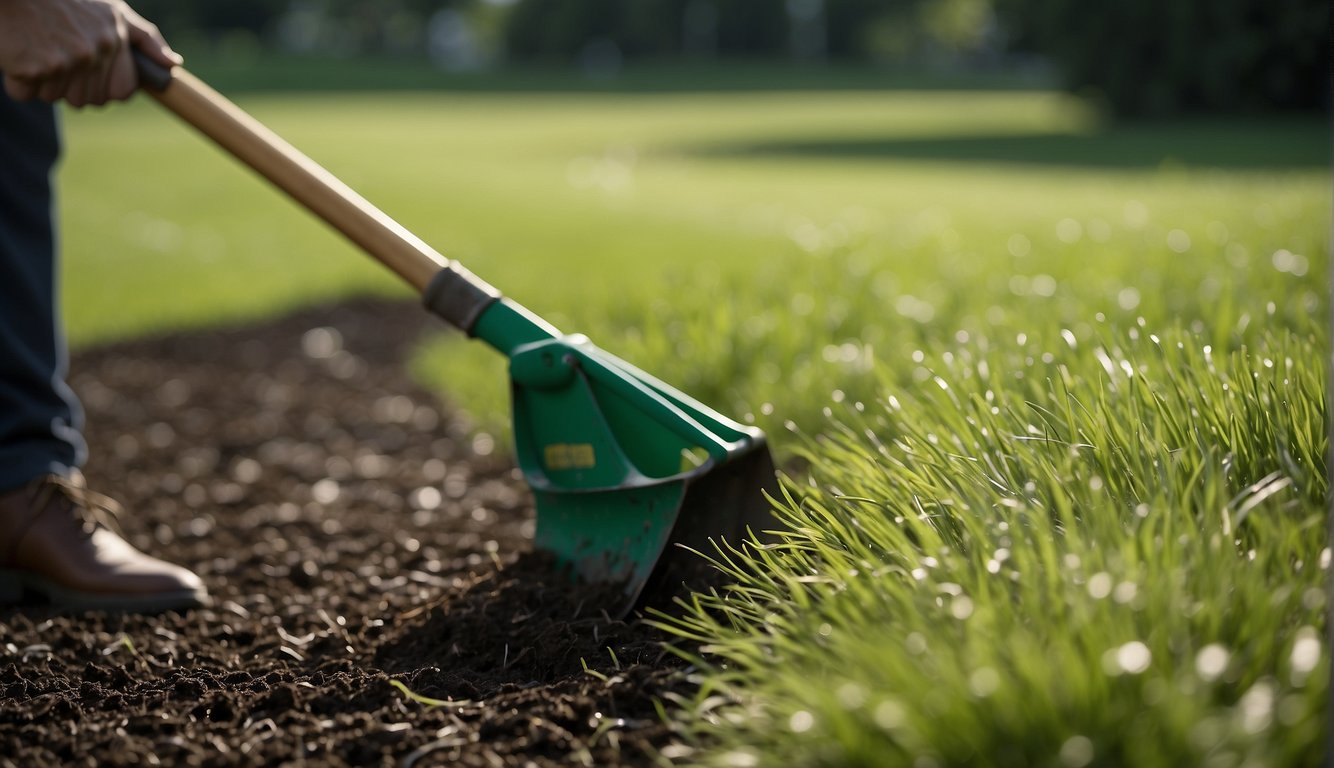
As a lawn owner, maintaining a healthy and lush lawn is a top priority. A well-maintained lawn not only enhances the beauty of your home but also provides a place for relaxation and recreation. In this section, I will discuss some essential tips for maintaining a healthy lawn.
Mowing Techniques
Proper mowing techniques are crucial for maintaining a healthy lawn. When mowing, it is recommended to cut only one-third of the grass blade’s height. Cutting more than one-third of the grass blade can lead to thatch buildup, which can be harmful to the lawn.
It is also essential to keep your mower blades sharp to ensure a clean cut. Dull blades can tear the grass, leaving it susceptible to disease and insect damage.
Watering and Fertilizing
Proper watering and fertilizing are essential for maintaining a healthy lawn. It is recommended to water your lawn deeply and infrequently rather than shallow and frequently. This helps the roots grow deeper and retain moisture, making your lawn more drought-resistant.
Fertilizing your lawn provides essential nutrients that promote healthy growth and disease resistance. It is recommended to fertilize your lawn in the spring and fall when the grass is actively growing.
Weed and Disease Control
Weeds and diseases can quickly take over a lawn, making it unsightly and unhealthy. To prevent weed growth, it is recommended to mow your lawn regularly and to use a mulching mower to suppress weed seeds. If weeds do appear, it is best to remove them manually or use an herbicide.
Lawn diseases can be prevented by maintaining proper mowing height, watering deeply and infrequently, and fertilizing regularly. If you suspect your lawn has a disease, it is best to consult a professional.
By following these tips, you can maintain a healthy and vibrant lawn that will be the envy of your neighborhood.
Enhancing Garden Beds

As a gardener, I know that keeping garden beds healthy and weed-free is essential for maintaining a beautiful outdoor space. One of the most common problems that gardeners face is how to keep grass clippings out of mulch beds when mowing. In this section, I will share my knowledge about enhancing garden beds, and how to prevent unwanted plants from growing in your mulch beds.
Mulch Bed Care
Mulching is an essential part of garden bed care. It helps to retain moisture in the soil, prevents weed growth, and adds nutrients to the soil as it decomposes. However, it is important to choose the right type of mulch for your garden bed. Organic mulches, such as wood chips, leaves, and grass clippings, are great for retaining moisture and adding nutrients to the soil. Inorganic mulches, such as gravel and stones, are great for preventing weed growth and adding a decorative touch to your garden bed.
When applying mulch, it is important to apply it evenly and at the right depth. A layer of 2-3 inches of mulch is sufficient to prevent weed growth and retain moisture in the soil. However, if the mulch is too thick, it can prevent water and sunlight from reaching the soil, which can be harmful to your plants.
Preventing Unwanted Plants
Preventing unwanted plants from growing in your garden bed is essential for maintaining a healthy and beautiful outdoor space. One of the most common problems that gardeners face is how to keep grass clippings out of mulch beds when mowing. Grass clippings can quickly turn into a breeding ground for weeds, which can be harmful to your plants.
To prevent unwanted plants from growing in your garden bed, it is important to remove any weeds or grass that are already present. This can be done by hand, or with the help of a hoe or cultivator. Once the weeds have been removed, it is important to apply a pre-emergent herbicide to prevent weed seeds from germinating.
Another way to prevent unwanted plants from growing in your garden bed is to create a barrier between the garden bed and the surrounding lawn. This can be done by installing edging or by creating a trench around the garden bed. The barrier will prevent grass clippings from entering the garden bed and creating a breeding ground for weeds.
Enhancing garden beds is essential for maintaining a beautiful outdoor space. By following these tips for mulch bed care and preventing unwanted plants, you can keep your garden beds healthy and weed-free.
Tools and Equipment Maintenance
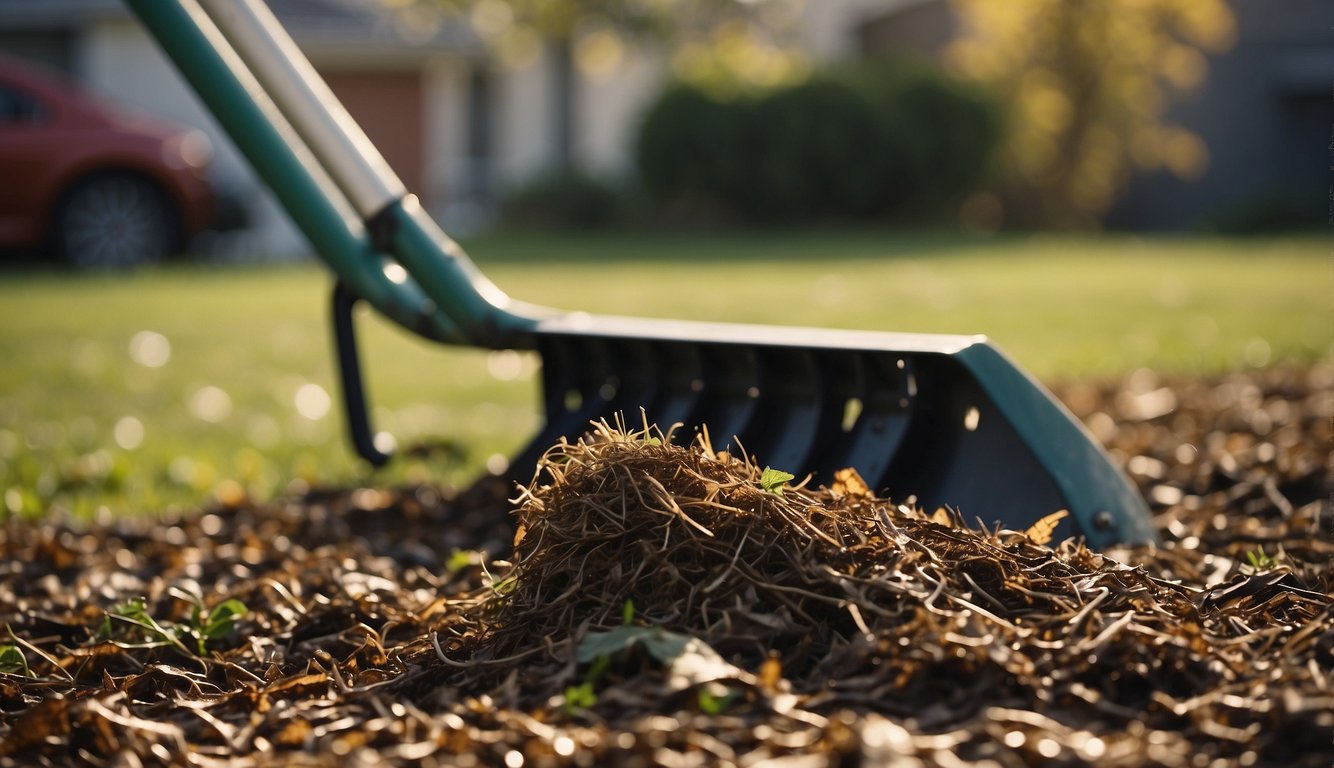
Cleaning After Use
As a landscaper, I know how important it is to maintain your tools and equipment. After using your tools to remove grass clippings from mulch, it is essential to clean them properly. I recommend using a brush or a cloth to remove any debris and dirt. You can also use a hose to wash off any remaining dirt. Once you have cleaned your tools, make sure to dry them before storing them.
Proper Storage
Proper storage is also crucial to keep your tools and equipment in good condition. I recommend storing your tools in a dry and secure location, like a garage or a shed. You can use a tool rack or a pegboard to organize your tools and keep them easily accessible. Make sure to store your tools in a way that prevents them from getting damaged or exposed to moisture.
When it comes to equipment like lawn sweepers or bagging attachments, it is essential to follow the manufacturer’s instructions for proper storage. Some equipment may require disassembly or special care before storage. If you are unsure about how to store your equipment, refer to the user manual or contact the manufacturer for guidance.
Proper maintenance and storage of your tools and equipment will help prolong their lifespan and ensure they work effectively when you need them. By taking the time to clean and store your tools properly, you can save money and avoid the hassle of having to replace them prematurely.
Designing an Efficient Landscape
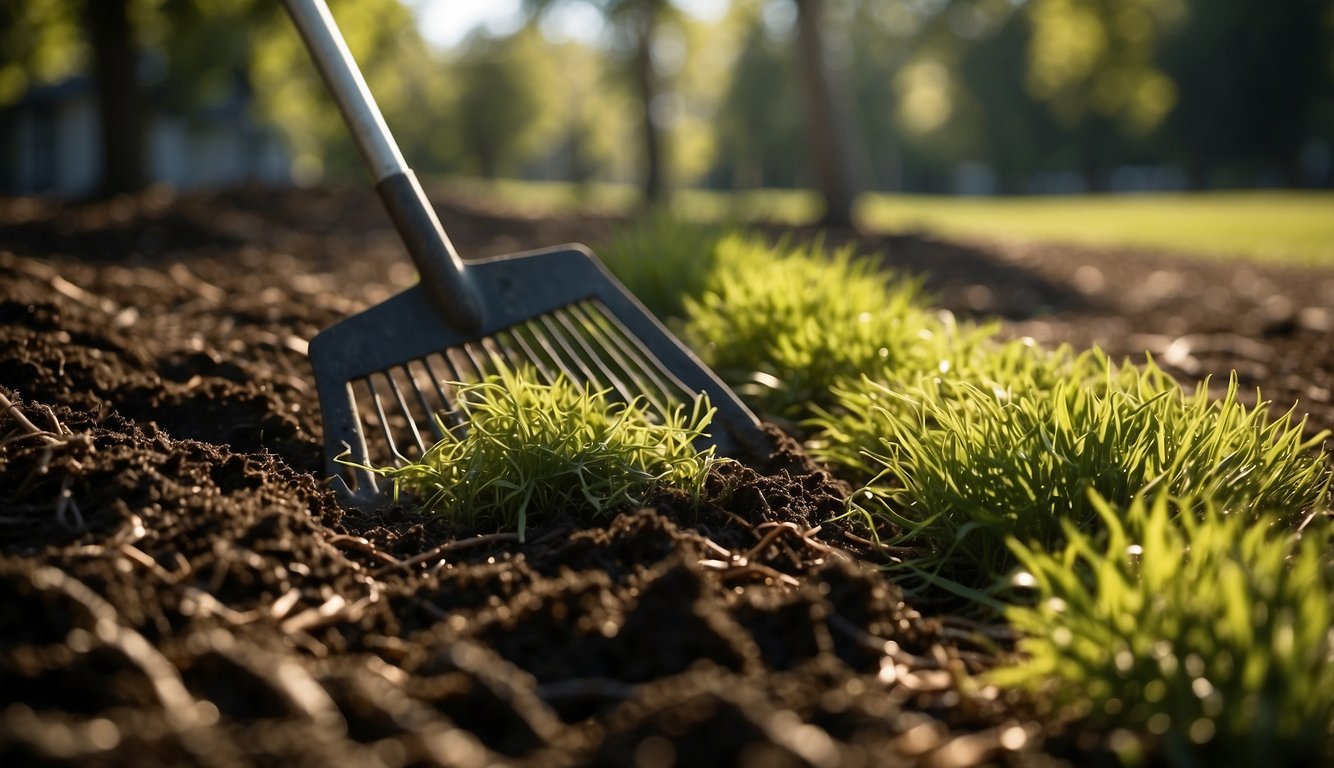
When it comes to designing an efficient landscape, there are a few key factors to consider. Incorporating borders and pathways can help keep grass clippings out of mulch beds, while choosing the right type of mulch can also make a big difference.
Incorporating Borders and Pathways
One of the best ways to keep grass clippings out of mulch beds is to incorporate borders and pathways into your landscape design. By creating clear boundaries between your lawn and your flower beds, you can help prevent grass from creeping into your mulch.
There are many different types of borders and pathways to choose from. Some gardeners prefer to use rocks or bricks to create a clear separation between their lawn and their flower beds. Others may opt for a more natural look, using plants or shrubs to create a natural barrier between the two areas.
No matter which option you choose, it’s important to make sure that your borders and pathways are well-maintained. This can help prevent grass and other debris from creeping into your mulch beds over time.
Choosing the Right Mulch
In addition to incorporating borders and pathways, choosing the right type of mulch can also help keep grass clippings out of your flower beds. There are many different types of mulch to choose from, including wood chips, straw, and even shredded leaves.
When choosing a type of mulch, it’s important to consider factors like water retention, nutrient content, and overall appearance. Some gardeners may prefer a mulch that is more decorative, while others may prioritize function over form.
It’s also important to make sure that your mulch is applied correctly. Mulch should be spread evenly over your flower beds, and should be at least two to three inches deep. This can help prevent grass and other debris from working their way into your mulch beds over time.
By incorporating borders and pathways into your landscape design, and choosing the right type of mulch, you can help keep your flower beds looking neat and tidy all season long.
How To Get Grass Clippings Out Of Mulch?
Let’s tackle a common garden conundrum: How to get grass clippings out of mulch?
Firstly, you can use a leaf blower. It’s a handy tool that can blow away the grass clippings without disturbing your mulch. Just be careful not to blow away your mulch!
Next, consider using a rake. A rake with flexible tines can gently remove grass clippings from the mulch. It’s a bit of work, but hey, gardening is a labor of love!
Ever heard of a mulch fork? It’s a special tool designed to lift and move mulch. It can help you remove grass clippings without disturbing the rest of your mulch. You check our homepage here.
And let’s not forget, prevention is better than cure! Consider using a grass catcher when mowing to prevent grass clippings from landing in your mulch in the first place.
Remember, folks, every problem has a solution. So, let’s keep gardening, keep learning, and keep enjoying the fruits (and veggies) of our labor!
For more gardening wisdom, don’t forget to visit my homepage at theherbprof.com. Keep those green thumbs up!
References – How To Get Grass Clippings Out Of Mulch?
Little Herb Encyclopedia, by Jack Ritchason; N.D., Woodland Publishing Incorporated, 1995
The Ultimate Healing System, Course Manual, Copyright 1985, Don Lepore
Planetary Herbology, Michael Tierra, C.A., N.D., Lotus Press, 1988
Handbook of Medicinal Herbs, by James A. Duke, Pub. CRP Second Edition 2007
The Complete Medicinal Herbal, by Penelope Ody, Published by Dorling Kindersley
Check the Following Articles!
Types of Kale Leaves: A Guide to Varieties and Uses
Is Beetroot the Same as Beets? Explained
Round Green Vegetable with Leaves: An Overview
Frequently Asked Questions – How To Get Grass Clippings Out Of Mulch?

What methods can be used to remove grass clippings from mulch beds?
There are several methods to remove grass clippings from mulch beds. One of the easiest and most effective ways is to use a rake or leaf blower to remove the clippings. Another option is to use a lawn sweeper to collect the clippings and dispose of them. Additionally, using a catcher while mowing the lawn can help to prevent clippings from getting into the mulch beds.
Can a lawn sweeper effectively clear grass clippings from mulch?
Yes, a lawn sweeper can effectively clear grass clippings from mulch. It is a great tool for removing large amounts of clippings quickly and efficiently. However, it is important to note that a lawn sweeper may not be suitable for all types of mulch beds, such as those with delicate plants or flowers.
What preventative measures can be taken to avoid grass clippings getting into mulch when trimming?
There are several preventative measures that can be taken to avoid grass clippings getting into mulch when trimming. One option is to use a catcher while mowing the lawn. Another option is to mow the lawn in the opposite direction from the mulch beds. Additionally, creating a barrier around the mulch beds using landscaping fabric can help to prevent clippings from getting in.
Is it beneficial to leave grass clippings in mulch, or should they be removed?
Leaving grass clippings in mulch can be beneficial as they can act as a natural fertilizer, providing nutrients to the plants. However, if the clippings contain weed seeds, it can transport them to other parts of the yard, allowing weeds to grow all over the yard. Therefore, it is recommended to remove the clippings if they contain weed seeds.
What tools are recommended for extracting grass clippings from mulch?
Some of the recommended tools for extracting grass clippings from mulch include a rake, leaf blower, lawn sweeper, and catcher. It is important to choose the right tool based on the type of mulch bed and the amount of clippings.
How can one clean grass clippings from mulch beds efficiently?
To clean grass clippings from mulch beds efficiently, it is best to use a rake or leaf blower to remove the clippings. If there is a large amount of clippings, using a lawn sweeper can be a more efficient option. Additionally, it is important to dispose of the clippings properly to avoid any further mess or damage to the yard.
